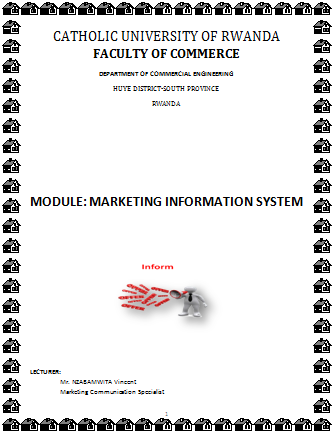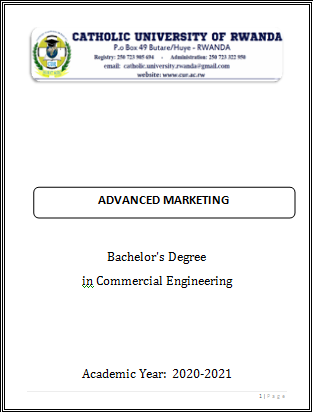
Marketing Information Systems
To understand the proper role of information systems one must examine what managers do and what information they need for decision making. We must also understand how decisions are made and what kinds of decision problems can be supported by formal information systems. One can then determine whether information systems will be valuable tools and how they should be designed. The module opens with a wide-ranging discussion of the functions of management, the various types and levels of decision that marketing managers must make. Managers play at least three separate roles: interpersonal, informational and decisional. MIS, in electronic form or otherwise, can support these roles in varying degrees. MIS has less to contribute in the case of a manager's informational role than for the other two. Three levels of decision making can be distinguished from one another: strategic, control (or tactical) and operational. Again, MIS has to support each level. Strategic decisions are characteristically one-off situations. Strategic decisions have implications for changing the structure of an organization and therefore the MIS must provide information which is precise and accurate. Control decisions deal with broad policy issues and operational decisions concern the management of the organization's marketing mix. Managers at all levels must make decisions on behalf of a company. The difference between decisions at various levels lies in the scope of the choices made. Long-term decisions affecting the company as a whole belong to the highest management levels, while decisions affecting day-to-day operations fall to bottom management. All decisions relate directly or indirectly to broader management functions: planning, organizing, leading, staffing and controlling. Different management levels spend more time on certain functions than on others. A marketing information system has four components: the internal reporting system, the marketing research systems, the marketing intelligence system and marketing models. Internal reports include orders received, inventory records and sales invoices. Marketing research takes the form of purposeful studies either ad hoc or continuous. By contrast, marketing intelligence is less specific in its purposes, is chiefly carried out in an informal manner and by managers themselves rather than by professional marketing researchers.

MODULE INTERNET &WEB DESIGN
AIMS
Module consists of two components “Internet Marketing” and “Web Design”.
#1. This unit deals with concepts of internet, e-mails, web pages, web advertising, internet protocols, equipment used for internet connectivity, providing domain names, etc.
#2. This unit deals with all the internet technologies. Student must be familiar with some of the latest concepts of internet, in-depth knowledge is not required but layer information will be enough. In response to a stated business problem, students will be able to create a complete Web-based solution. This course also covers using Dreamweaver to create Web pages.
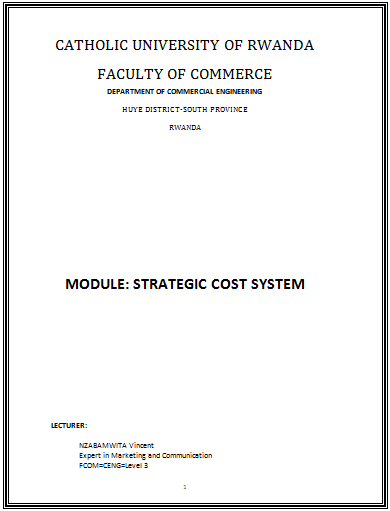
STRATEGIC COST SYSTEM-OK
The aim of strategic cost system is designed to
monitor the costs incurred by a business. The system is comprised of a set
of forms, processes, controls, and reports that are designed to aggregate and
report to management about revenues, costs, and profitability.
A strategic cost system (also called product costing system or costing system) is a framework used by firms to estimate the cost of their products for profitability analysis, inventory valuation and cost control.
Estimating the accurate cost of products is critical for profitable operations. A firm must know which products are profitable and which ones are not, and this can be ascertained only when it has estimated the correct cost of the product. Further, a product costing system helps in estimating the closing value of materials inventory, work-in-progress and finished goods inventory for the purpose of financial statement preparation.
Cost system refers to the classifying, recording and appropriate allocation of expenditure for the purpose of determining the costs of products or services. It also helps in the presentation of arranged data for the control purposes and guidance to the management. Cost system deals with the production, selling and distribution costs. It involves the ascertainment of the cost of every job, order, product, process or service. Here, we shall discuss the various objectives of cost system. To enable students to easy understand by describing or giving information about the aims, objectives, methods of cost system, roles, elements of cost system. The students may acquire different role of strategic cost system and design cost system of any organization.
Learning Outcomes
Knowledge
Having successfully completed the module, students should be able:
- To know the meaning of key concepts of strategic cost system
- To know the roles, elements and attributes of strategic cost system
- To know the stages of cost system design project and cost system set up, testing
Skills
After completing the module, successful students should be able:
ü To gain familiarity with a phenomenon of strategic cost system
ü To portray the roles, elements and attributes of strategic cost system
ü To deliver cost system design project and cost system set up, testing
Attitude
Having successfully completed the module, students should be able to demonstrate knowledge of:
ü Defining very well the key concepts of strategic cost system
ü Explaining roles, elements and attributes of strategic cost system.
ü Easy understanding by describing the stages of cost system design project,
Learning and Teaching strategy
Activities and methods used to move the learner towards achievement of the learning outcome. Basic knowledge and understanding are developed in lectures which contain explanations of techniques and strategies.
There will be exercises and assignment to enable the students to reflect on and deepen what they are learning. Some works will be done individually, others in groups Lecture notes are provided at the beginning of the module delivery.
Assessment Strategy
The teaching methods will align with the outcome and with the outcome evaluation. There will be a lot of assessment during the module delivery some of which will be recorded and constitute 60% of the final mark. At the end of the module there will be a final written examination which will count 40%.
Assessment Pattern
|
Component |
Weighting (%) |
Learning outcomes covered |
|
Continuous Assessment and Test (CAT) |
60% |
Refer to Learning outcomes |
|
Final Exams |
40% |
Refer to Learning outcomes |
Strategies for feedback and student support during the module
ü Continuous assessment techniques
ü Assignments with immediate feedback
Lecturer’s availability for consultations for which office hours will be announced in advance and respected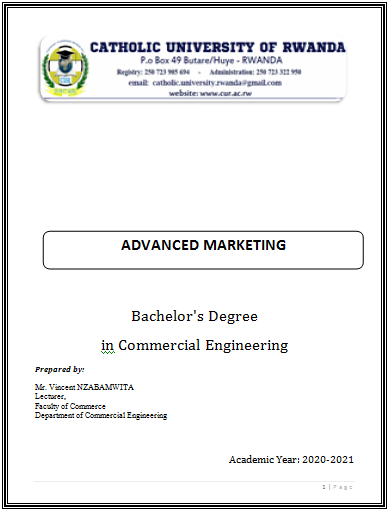
ADVANCED MARKETING-OK
Marketing
consists of dynamic activities that focus on the customer to generate a
profitable exchange. The goal of marketing is to meet customers’ needs and
wants with products that customers can and will buy. Whereas advanced
marketing means development of different product/service to different people’s
needs/wants that involve encouraging people to buy a product or service.
To enable students to understand the definition and meaning of advanced marketing, consumer behavior and customer relationship. To know the nature, scope and application of consumer behavior and customer relationship. To analyze consumer environment, marketplace, Markets and marketing. in addition to understand the marketing strategy and consumer behavior, different views on customer, managing customer relationships, building customer relationship, capturing value from customers, customer relationship marketing, to understand the reasons why business relationships fail.
Learning Outcomes
Knowledge
Having successfully completed the module, students should be able to:
1) Identify the different types of consumer behavior;
2) Develop different types of customers relationship to different people’s needs/wants;
3) Encourage people to buy a product or service.
Skills
After completing the module, successful students should be able to:
1) To obtain familiarity with a consumer behavior and customer relationship
2) To describe the characteristics of a particular individual, situation or a group, organizations as consumer;
3) To manage customer relationship and capturing the value from customer
4) To understand the goals of customer relationship marketing and the reasons why business relationship fail.
Attitudes
Having successfully completed the module, students should be able to demonstrate attitude of:
1) Defining and meaning of advanced marketing, consumer behavior and customer relationship;
2) Understanding the Nature, Scope and Application of Consumer Behaviour;
3) Knowing of the buying process, distinguish between low-involvement buying decisions and high-involvement buying decisions, and factors that affect people’s buying behavior
4) Analysis of Consumer Environment, Marketplace, and Markets and Marketing
Learning and Teaching Strategy
Activities and methods used to move the learner towards achievement of the learning outcome. Basic knowledge and understanding are developed in lectures which contain explanations of techniques and strategies.
There will be exercises and assignment to enable the students to reflect on and deepen what they are learning. Some works will be done individually, others in groups Lecture notes are provided at the beginning of the module delivery.
Assessment Strategies
The teaching methods will align with the outcome and with the outcome evaluation. There will be a lot of assessment during the module delivery some of which will be recorded and constitute 60% of the final mark. At the end of the module there will be a final written examination which will count 40%.
Assessment Pattern
|
Component |
Weighting (%) |
Learning outcomes covered |
|
Continuous Assessment and Test (CAT) |
60% |
Refer to Learning outcomes |
|
Final Exams |
40% |
Refer to Learning outcomes |
Strategies for feedback and student support during the module
1) Continuous assessment techniques
2) Assignments with immediate feedback
3) Lecturer’s availability for consultations for which office hours will be announced in advance and respected.
Operational research
To
enable the students to become familiar with the various operations research
models and their usage in business decision-making some of the primary tools
used in operations research are statistics, probability theory and simulation. These techniques are the most
appropriate given the nature of the system, the goals for improvement, and
constraints on time and computing power
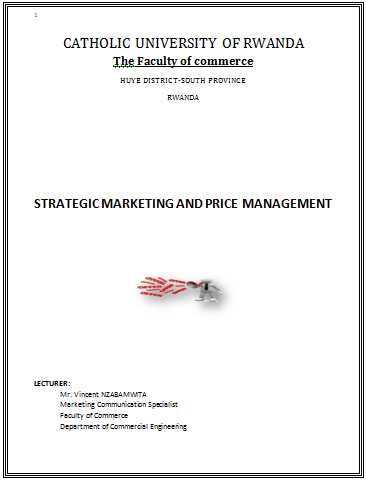
STRATEGIC MARKETING AND PRICE MANAGEMENT-OK
MODULE NAME: STRATEGIC MARKETING AND PRICE MANAGEMENT
LEVEL: 5 Semester: II
|
Module code |
Module No. |
Course name |
Subject units |
Credits |
|
MAIS5213 |
|
STRATEGIC MARKETING AND PRICE MANAGEMENT |
Pricing strategies |
10 |
|
Consumer and competitor analysis |
10 |
|
Year (the module is thought in which year?) |
Theoretical (Hours) |
Practical (Hours) |
Total hours |
Credits |
|
Level four |
80 |
120 |
200 |
20 |
Allocation of Study Hours
|
Module Outline |
Student hours |
Lecturer Hours |
|
Face to face Lectures |
60 |
60 |
|
Seminar/workshops |
- |
- |
|
Practical classes/laboratory |
- |
- |
|
Structured exercises |
30 |
10 |
|
Set reading |
20 |
- |
|
Self-directed study |
50 |
- |
|
Assignments-preparation and writing |
40 |
10 |
|
TOTAL |
200 |
80 |
Brief description of aims and content
The aim of this strategic marketing and price management module is to enable students to analyse the pricing strategies and consumer and competitors. A business can use a variety of pricing strategies when selling a product or service. The price can be set to maximize profitability for each unit sold or from the market overall. It can be used to defend an existing market from new entrants, to increase market share within a market or to enter a new market.
Pricing is one of the most vital and highly demanded components within the theory of marketing mix. It helps consumers to have an image of the standards the firm has to offer through their products, creating firms to have an exceptional reputation in the market.
Whereas the competition within the market today is extremely high, for this reason, businesses must be attentive to their opponent’s actions in order to have the comparative advantage in the market. The American Marketing Association defines market research as: "The systematic gathering, recording, and analysis of data about problems relating to the marketing of goods and services". Consumer analysis is an important part of this marketing research. Without marketing research, it is quite impossible today to start any business. Consumer analysis is the first step of any marketing research.
In this module, the objectives are to develop the skills in pricing strategies and consumer analysis.
Learning Outcomes
Knowledge
Having successfully completed the module, students should be able:
ü To know the Roles, Approaches, Policies and objectives of pricing strategies
ü To know the influencing factors and Product life cycle
ü To know the national and international Pricing strategies
ü To know the consumer analysis and customer profitability
ü To know the business idea, competitor analysis and competitive strategies
Skills
After completing the module, successful students should be able:
ü To define the Roles, Approaches, Policies and objectives of pricing strategies
ü To differentiate the influencing factors and Product life cycle
ü To differentiate the national pricing strategies and international Pricing strategies
ü To deliver the business idea, competitor analysis and competitive strategies
Attitude
Having successfully completed the module, students should be able to demonstrate attitude of:
ü Illustrating the Roles, Approaches, Policies and objectives of pricing strategies
ü Understanding the influencing factors and Product life cycle
ü Analyzing the various the national pricing strategies and international Pricing strategies
ü Defining the business idea, competitor analysis and competitive strategies
Learning and Teaching strategy
Activities and methods used to move the learner towards achievement of the learning outcome. Basic knowledge and understanding are developed in lectures which contain explanations of techniques and strategies.
There will be exercises and assignment to enable the students to reflect on and deepen what they are learning. Some works will be done individually, others in groups Lecture notes are provided at the beginning of the module delivery.
Assessment Strategy
The teaching methods will align with the outcome and with the outcome evaluation. There will be a lot of assessment during the module delivery some of which will be recorded and constitute 60% of the final mark. At the end of the module there will be a final written examination which will count 40%.
Assessment Pattern
|
Component |
Weighting (%) |
Learning outcomes covered |
|
Continuous Assessment and Test (CAT) |
60% |
Refer to Learning outcomes |
|
Final Exams |
40% |
Refer to Learning outcomes |
Strategies for feedback and student support during the module
Ø Continuous assessment techniques
Ø Assignments with immediate feedback
Ø Lecturer’s availability for consultations for which office hours will be announced in advance and respected
